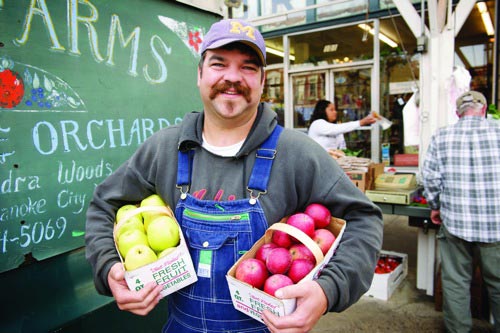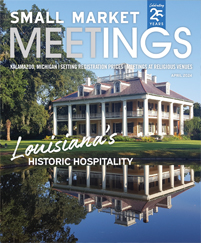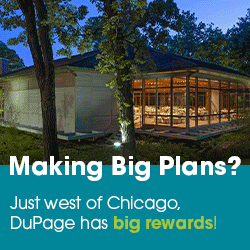
Courtesy Roanoke Valley CVB
Farmers market is an anchor
Another essential anchor downtown is a year-round farmers market, the oldest outdoor market in continuous operation in Virginia. With 42 permanent stalls along Market Street, City Market shields its vendors under blue-and-white awnings. The market is closed only on Christmas and New Year’s Day.
City Market is among the keys to a bustling downtown. Some 12,000 people work in downtown Roanoke; by the end of 2011, about 1,200 had moved to condominiums, apartments and other new housing in the city center. On the Rise Bakery, women’s clothier La De Da, Little Dipper and Beads Indeed are a sampling of downtown’s 60 retailers.
In September, the City Market Building, a downtown staple at the foot of the City Market, reopened. Built in 1922 to house butchers and fishmongers, it is today an emporium of local food vendors. Since 1985, a collection of quick-service eateries have filled its food court; two years ago the city closed the building and did a $8 million revamping, upgrading everything from paint to plumbing.
Among its dining options are homemade soups and paninis at Firefly Fare; homemade spinach- and-cheese pies from Euro Bakery, and ceviche, tamales and roasted pork at Habana Cafe.
The building’s return is good not only for downtown workers who grab lunch there, but also for meeting-goers at the nearby Hotel Roanoke, who can go there for a lunch break.
The market building’s third floor, once the Roanoke Opera House, has become Charter Hall, a ballroom that seats 300 for sit-down dinners and 450 for meetings. With its own stage, it is well suited for awards dinners or presentations.
Across the street, workers are busy on a massive redo of Center in the Square, Roanoke’s theater and museum complex, built in a former warehouse that abuts the downtown market.
Like the old, the new Center in the Square will be home to a science museum, a western Virginia history museum, a Native American culture museum and the Mill Mountain Theatre.
It will have new features as well: a 5,500-gallon coral reef aquarium with 250 marine fish and three smaller aquariums with jellyfish and seahorses; and a green rooftop where more than 30 photovoltaic panels will collect solar energy, turbines will collect wind energy, a special habitat will nurture butterflies and rainwater will be harvested for use in a rooftop koi pond. A restaurant will serve diners; visitors will have shady places to sit, relax and reflect.
The $30 million project will be completed in early spring of next year; the facility will be available for events and a rental package is being developed, according to Lynn Donnary, marketing manager.
These developments and others represent a $250 million investment in downtown, according to Sean Luther, president and CEO of Downtown Roanoke. “The cones are out,” said Luther. “Downtown Roanoke has things that larger cities would kill to have.”
Tracks tie two venues
The Norfolk Southern mainline tracks that divide downtown from the Hotel Roanoke are anchored by two popular off-site venues, five blocks apart.
Closest to the heart of downtown is the Taubman museum, which is more than an interesting place to view art. The lobby, with its three-story glass ceiling and sweeping glass staircase can easily accommodate more than 650 for cocktails; a terrace that looks toward Mill Mountain, home to Roanoke’s lighted, star-shaped beacon, is a good place for casual conversations when attendees take a break from business in an adjoining 18-person boardroom.
An educational rail walk that runs alongside the railroad tracks leads from the Taubman to the Virginia Museum of Transportation. The museum has quite an automotive and air transportation collection, but its star is railroad rolling stock and memorabilia.
“There is no better rail collection in the country,” said Bev Fitzpatrick, museum director. “People come to Roanoke from all over the world to see these locomotives.”
The museum is housed in a 1918 Norfolk and Western freight station. “This is where anything and everything that came to Roanoke came in, and we are in the midst of putting it on the Historic Register,” Fitzpatrick said.
Indoors, groups can gather in new 48-seat theater, part of a safety instruction car, or party among the museum’s automotive collection, examining oddball vehicles like a 1928 Willys Overland Whippet and a Siebert Ford Combo Ambulance/Hearse from 1936, as the museum’s collection of neon signage glows above them.
On nice evenings, they can wander outside to the covered pavilion that holds the museum’s rolling stock, including its prides — the Class A-1218 and the Class J-611 — two steam engines, both produced at Norfolk and Western shops in Roanoke, both the lone survivors of their class of steam engines.
Standing next to the massive machines that pulled everything from World War II troops and tanks to long passenger trains brings an even deeper appreciation for Roanoke’s part in the nation’s past.
The museum’s artist-in-residence, Andy Fletcher, ponders the trains that pass by from his studio overlooking the tracks. “When you see a train, you wonder where it’s been and where it is going.” They are, like Roanoke, steaming strongly into the future, never forgetting the journeys of the past.











